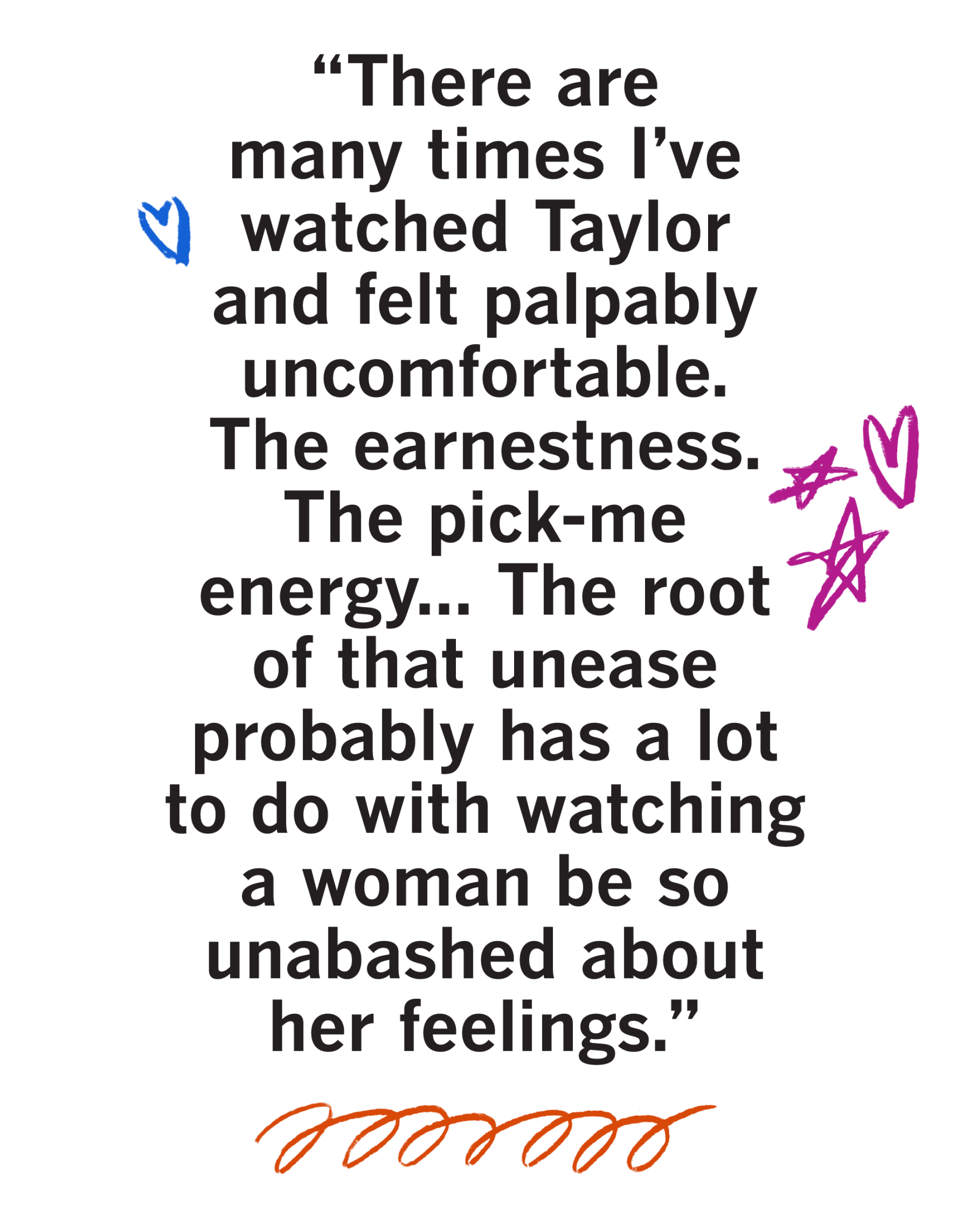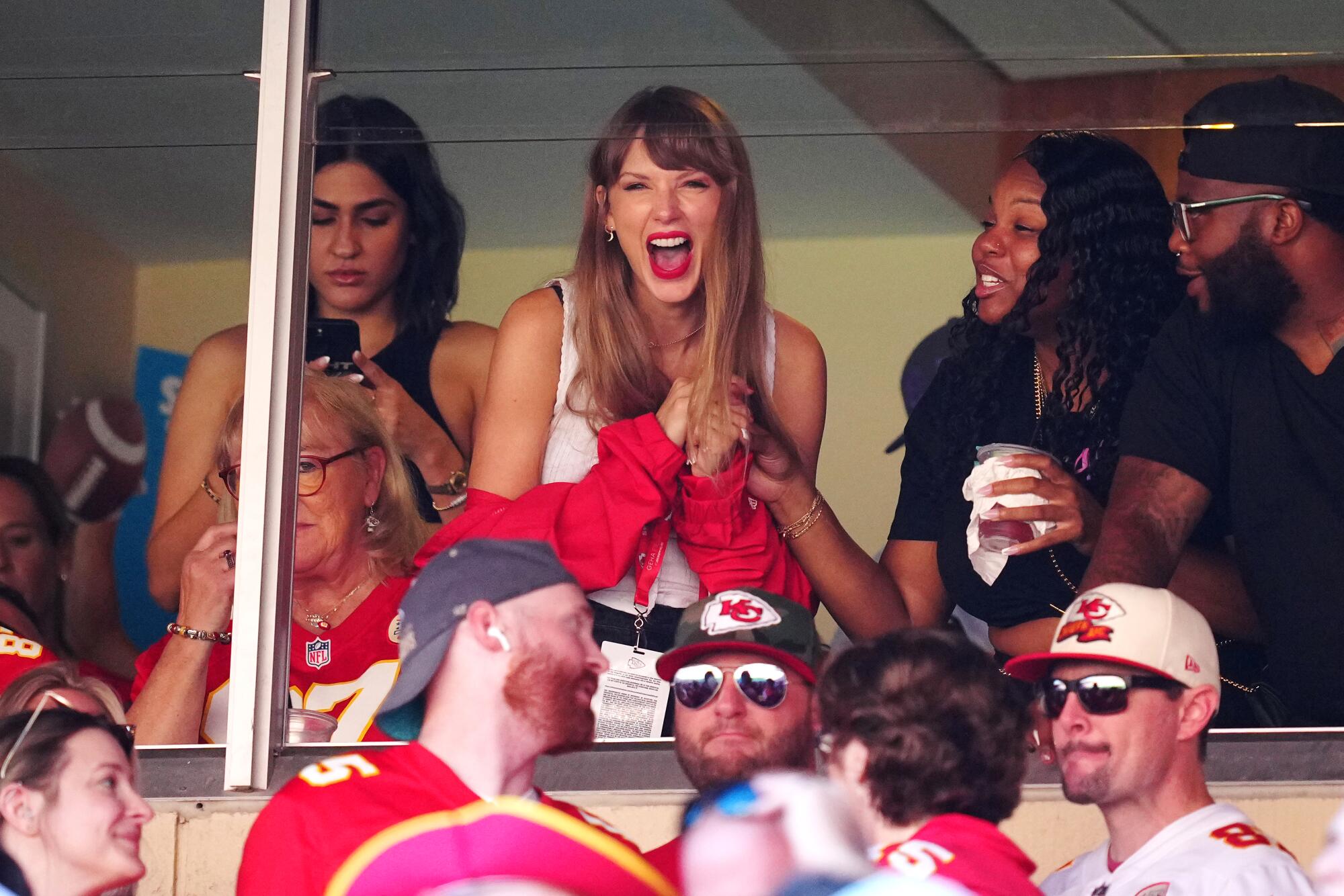When my family gathers around the table for the holidays, we all take turns sharing what we’re grateful for. This year, my list began predictably enough: Health, job, boyfriend, dog.
“Oh,” I added, “and Taylor Swift and Travis Kelce.”
My father scoffed. He couldn’t comprehend why a pop star and a football player could mean so much to me.
Though I’d mentioned them (partly) in jest, I found myself attempting to describe what I felt was particularly affecting about their relationship: She was finally with a guy who seemed to appreciate her. He was famous enough that he didn’t seem intimidated by her superstardom. And they were just so pretty and happy and sweet together!!!
Dad sighed.
“Can you pass the sweet potatoes please?”
He would have been far more perplexed — borderline horrified — if I’d revealed how deep my new obsession went. After years of acting like a full-on brat whenever my partner put sports on TV, I was suddenly planted right beside him whenever a Kansas City Chiefs game was on. My friends and I made bets on how soon Taylor and Travis would get engaged.
Worst of all was the video.
Conservatively, I had watched a clip of Taylor and Travis kissing after her concert in Argentina 100 times. Maybe more, because new angles of the Nov. 11 embrace kept dropping on TikTok — each offering a better view than the last of their first public PDA.
If you don’t know what I’m talking about, I’m sorry your life is so miserable. Let me set the scene: Taylor has just played a sold-out show for 85,000 people in Buenos Aires, the first with Travis in tow as her boyfriend. He has spent the entirety of the three-hour concert singing and dancing in the VIP tent next to Taylor’s dad, who is wearing a Chiefs lanyard around his neck. And when she changes her lyrics to make them about him — “karma is a guy on the Chiefs, coming straight home to me” — he puts his hands on his cheeks in adorable disbelief.
The clip captures Taylor leaving the stage in one of her signature bedazzled bodysuits, waving goodbye to her fans. The instant she spots Travis, awaiting her with his hands held politely behind his back, she runs to him. He smiles and shakes his head, like he can’t believe his luck. She throws her arms around his neck and kisses him. Their lips remain locked as they spin around slowly. She whispers something in his ear as he continues to hold her close. Confetti falls. Fans shriek. Then they disappear from view.

I’ve never been a diehard Swiftie. I attended the Eras tour, but I wasn’t moved to tears. I don’t parse her lyrics for Easter eggs or eagerly await the release of each Taylor’s Version album. And prior to Travis, I’d never been all that invested in her romantic life — particularly the Joe Alwyn phase. (Hard pass.) And yet, like seemingly every other pop-culture obsessive the world over, that moment in Argentina turned me into a de facto body-language expert, a consumer of countless TikTok videos and “Today Show” segments, a hopeless romantic, a true believer.
Suddenly, I found myself a not-so-neutral observer in the very sort of story I was trained to cover: how a hitmaking blond and a good-natured tight end managed to capture the attention of a divided nation, increasing NFL ratings, boosting Kelce jersey sales and somehow making Taylor even more ubiquitous than she already was.
What was it about that clip of them kissing that made me — made us — feel so damn good?

“What kind of good? That’s important.”
I’m on the phone with Dr. Helen Fisher, a biological anthropologist and senior research fellow at the Kinsey Institute who has spent her career studying brain imaging to understand how love impacts humans.
My Taylor-and-Travis infatuation felt like the gooey, swelling in your throat kind of good. The suspended in some dreamy place where all of life’s promise is fulfilled kind of good. A feeling, Fisher suspects, that comes from oxytocin, a hormone produced by your brain that gives you a sense of calm, of sweetness.
“It’s the basic neural mechanism of attachment,” she says. Others might have seen that moment in Buenos Aires and experienced a dopamine surge — “a feeling of intense pleasure, energy, motivation and optimism” that is often correlated with the rapture of romantic love.

Even if we voyeurs are not kissing Taylor or Travis ourselves, our bodies can still experience the same chemical reactions just from watching them. Even Fisher, who was unfamiliar with Taylor’s career and viewed the clip for the first time after our call, found herself as moved as I was: “It was totally CHARMING — so real, so human, so unrehearsed and so dramatic,” she emailed later. The phenomenon behind it is called “emotional contagion,” according to Fisher — the reason why we tear up when our friends cry or get hungry when those around us are eating.
Taylor Swift is patient zero for emotional contagion.
When she got her start at 17 years old, she presented the image of a teenage girl who longed for a life just out of her grip: On her eponymous debut album, released in 2006, she sang about crying in her room, writing songs about a boy who liked a girl who “got everything that I have to live without.”
Since then, as she’s conjured entire worlds that transport listeners to high school hallways, moss-covered cabins and country road trips, that energy continued to course through her music, creating an identifiable, relatable heroine who carries through her work. The narrator of her songs was a young woman who never felt fully seen by her romantic partners. “Sometimes I feel like everybody is a sexy baby / And I’m a monster on the hill.” She’d always try to save a relationship, but he’d take the easy road out and run. And he never valued her, anyway. “Don’t put me in the basement / When I want the penthouse of your heart.” So fine, leave, she cautioned. But you’ll never be able to forget me. “I left my scarf there at your sister’s house / And you’ve still got it in your drawer even now.”
And then: Travis. This man who seems like the ultimate heteronormative prize. Sickeningly attractive, extremely athletic and, against all odds, not a jerk. He looks like the kind of bro who would date a Victoria’s Secret model at least a decade his junior. The kind of girl Taylor once crooned about being passed over for in high school: “She wears short skirts / I wear T-shirts / She’s cheer captain, and I’m on the bleachers.”

Travis going for the girl on the bleachers felt monumental — not only because Taylor finding her dream man would be a culmination of everything she’d written about for nearly two decades, but because I was once on the bleachers too.
Freshman year, the world at my New England prep school broadened — if only nominally — with the arrival of boarding students, 60 or so newcomers added to a campus that resembled a miniature Ivy League university. The quarterback recruited to lead our football team was one of them.

Taylor Swift reacts during the Chiefs’ game against the Chicago Bears in Kansas City in September.
(Jason Hanna / Getty Images)
He hadn’t traveled far — his hometown was about the same distance from school as Malibu is from Silver Lake — but was unlike any boy I’d never encountered. Sporting a thick Boston accent and a gold chain, he looked like the hot member of a boy band, and he could move like one too — proudly reenacting the choreography from NSYNC’s “Bye Bye Bye” music video at school dances, a skill that was somehow considered cool.
Soon after his arrival, my best friend and I were circling the quarterback’s picture in the student telephone directory. We were already boy-crazy, having spent junior high filling a shared notebook with code names for the guys we liked. But neither of us expected him to reciprocate our interest. Thanks to her Carhartt beanie and Birkenstock clogs — and my miniskirts (even in winter) and kohl pencil eyeliner — we didn’t look like the popular girls at school, with their straightened hair, North Face fleeces and Ugg boots. I had attracted the interest of some boys — I’d made out with one guy at summer camp and another had written me a letter saying he loved me — but mostly I wrote short stories about my crushes. The girls who summered on Nantucket and eschewed carbs? Their crushes were requited.
As the fall rolled on, though, the quarterback started choosing a seat next to me and my best friend so we could whisper about anything other than lab results. He became the lone muscular guy with a clutch of artsy girls. He even started referring to us both as “kid,” which we found endearing, not condescending.
At night, after I’d driven home and he’d returned to his dorm room, the quarterback and I would spend hours talking on AOL Instant Messenger. These were the interactions I most treasured. Alone at his keyboard, he would share things that I suspected he kept from others — his fears that he was intellectually inferior to our peers, his struggles with his dad, his feelings for other girls. I listened intently, hoping he’d someday realize I was the girl he should have been with all along. That he’d wake up and find what he was looking for had been there the whole time.
Toward the end of freshman year, we all started hanging out at the house of a friend who had a big basement and inattentive parents. At the last party before school let out for the summer, we played Spin-the-Bottle and the empty Coke can the quarterback spun landed on my best friend. They kissed, and later, in the glow of the pool, he confessed he had a crush on her.
“She gets absolutely every guy, grade, makes everything I don’t — all of the things that I genuinely want,” I wrote in my diary. “I love her so much but at the same time I’m so jealous of her — when I’m with her I feel like I’m nothing.”
I was set to leave for camp the next day. I spent my remaining hours at home in front of our boxy PC, waiting to hear the chime as the quarterback’s screen name popped up. But he never signed on.
The thought of sitting on my feelings for eight long weeks at camp, where my communication was limited to letters and a precious few payphone calls, was unbearable.
So I put on the headset my dad used for his work calls and recorded a voice note. I told the quarterback that I liked him, that I was overwhelmed by jealousy, that I hoped my confession didn’t ruin our friendship. I cried. And then I attached the .wav file to an email, pressed send and left for two months in Maine.
A month later, his response arrived at my bunk.The letter was three pages long, typed in all-caps. At first, he wrote mostly about his summer, which he said was boring: He spent five hours at the gym each morning, then used any money he had “PIMPIN OUT” his Ford Explorer. He’d gone to a Backstreet Boys concert and gave a bad review to the new NSYNC album, which he admitted to stealing from Sam Goody.
And then, finally, he addressed the recording. He’d listened to it 20 times, he said, each time feeling more like a jerk.
“YOU WERE DEFINITELY THE ONE PERSON I COULD COUNT ON THE WHOLE SCHOOL YEAR TO BE THERE FOR ME WHEN I FELT S—,” he said. “AND LOOKIN BACK I PRETTY MUCH FELT S— THE WHOLE TIME I WAS THERE.”
I hadn’t jeopardized our friendship, he promised. Nothing would change between us. He gave me his number and told me to call him.
“REMEMBER DON’T DO ANYTHIN I WOULDN’T DO,” he signed off. “NO SMOKIN OR DRINKIN CUZ I SAID SO … I LOVE YOU BABE .. COME HOME SOON AND WRITE BACK CUZ I KNOW U HAVE MADD WRITING SKILLS!!”
When I got back to school that fall, the QB and my BFF made their relationship official. They weren’t a couple for long — six months, tops. My best friend doesn’t even remember, now, why they broke up. The quarterback was just a blip in her romantic history. And the truth is, he was just a blip for me too. I knew, even as I recorded that message freshman year, that he viewed me platonically, and that nothing I could say would change that. I understood that it would be ludicrous for him and my best friend to abstain from dating simply because of me. In retrospect, what I wanted was for someone to know how hard it felt to be 15-year-old me. I wanted the boy I liked to know the pain his lack of recognition was putting me through. I wanted all of my feelings to count for something.
I never did see the nobility of suffering in silence, as my best friend reminded me when I called her recently to talk about that time. I’d sent many long letters to high school boys, she said: “You were always falling hard.”

There are many times I’ve watched Taylor and felt palpably uncomfortable. The earnestness. The pick-me energy. “Do less” is a thought I had about her as recently as August, when she stood, mouth agape, in supposed awe at her crowd’s endless standing ovation.
The root of that unease probably has a lot to do with watching a woman be so unabashed about her feelings. I was that way when I was 15, sure. But as soon as I hit college, the pressure to act like a disaffected cool girl seeped in. I started following asinine rules about how long to wait before texting a guy back. I acted like I was OK with casual relationships when I really wanted serious ones.
I wasn’t about to be burned again.
A few years after I sent the quarterback the audio recording, a friend who lived in his dorm told me that he’d played it aloud for his buddies in an effort to mortify me. Even though I’d moved past my crush by then, I felt a surge of embarrassment that quickly morphed into self-punishment. Surely anyone who was dumb enough to put a recording like that out into the world deserved what was coming to her.
That was, after all, the message conveyed to so many millennial women, myself and Taylor Swift included, when we were growing up. In that golden age of teen movies, of “Clueless” and “She’s All That” and “10 Things I Hate About You,” the uncool kid was almost always publicly humiliated. Outcasts were only invited to the prom, the party or the hangout as part of some elaborate trick: Pay me. Accept my makeover. Make me look like a better person. And to desire openly to be included, accepted, was the most “uncool” trait of all.

Things feel different now, and without ascribing too much power to Taylor Swift, I actually think she has something to do with it. She is certainly the emblem of a cultural shift away from shaming and toward embracing, if not the driver of it. If teenage Amy had sent that recording in 2023 and still been rejected, I imagine a Taylor-inspired voice in my head might say: “You spoke your truth. You put yourself out there. That’s brave. And you have nothing to feel bad about. He’s the one missing out.”
The quarterback came to mind while I was interrogating my obsession with Taylor and Travis because he was a jock who gave me the time of day. He also played football. He was also handsome and goofy and — usually — kind. But Travis did what for Taylor what the quarterback never could for me: He saw her.
He didn’t let fear of ending up in one of her songs stop him from shooting his shot. As he grinned from the audience while she performed onstage, it seemed this was the man who finally recognized how lucky he was to be with her. He wasn’t self-conscious when she shouted him out in front of millions of fans. He didn’t stop holding her hand when they encountered paparazzi.
And she got her happy ending — I hope, anyway — even though she shared too much or was cheesy or cringeworthy. Strike that: Taylor Swift got everything she wanted, professionally and now personally, because she shared too much, because she was all of those things — and because she showed legions of female fans taught to hide who they were someone who carved another path. Maybe that doesn’t make her “cool.” But she seems be something much more appealing: happy.

